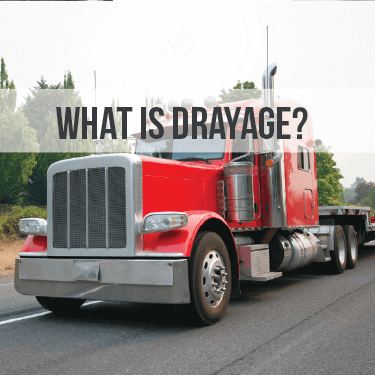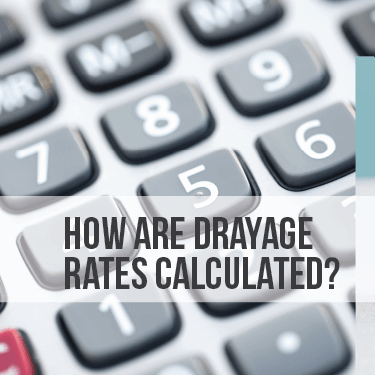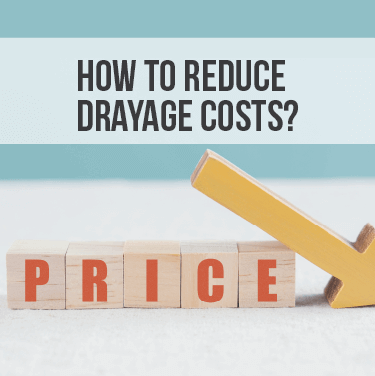Shippers often complain about the cost of drayage rates, particularly due to the fact that drayage is the shortest part of a freight shipment’s journey. But the fact of the matter is that drayage is an essential part of the shipping and logistics industry, and it’s important to understand the basics of drayage rates and how they’re calculated.
Drayage rates are comprised of a base fee, determined by the weight of the freight, handling required, and a number of other factors. Accessorial fees, including driver detention, tolls, and equipment costs are also a consideration. While it’s not possible to eliminate drayage fees entirely, there are ways to reduce drayage costs.
Our guide below outlines what drayage is, how to calculate drayage rates, and how to reduce the costs associated with drayage.

Drayage is an essential logistics service used to transport goods over short distances. Often referred to as the “first mile”, drayage is just one part of a much larger shipping process used to move freight to its final destination.
Drayage helps fill in the gaps in the supply chain by moving goods between ports, terminals, warehouses and retailers. Drayage services are almost always performed by truck, and because drayage is often the shortest link in the supply chain, multiple drayage moves can be completed by one driver in a single shift.
Most drayage carriers are what is called “power only”, meaning that they only provide the truck. Any additional equipment required, such as containers or chassis, must be provided to them. There are some carriers that provide their own chassis, but that is not the norm.
There are a number of details that go into calculating drayage rates.

The most common factors include:
Drayage carriers typically charge a base fee based on the factors above. Along with these, accessorial charges also come into play.
Some of these charges are known, meaning that the carrier outlines their rates and additional charges for things like fuel, detention times, toll charges, etc. when you hire them. Other times, however, you’ll run into unknown fees and charges that you won’t know about until after the job is completed.
As far as the base rate goes, freight is measured in hundred-pound increments, or CWT. A carrier will typically set a certain rate, depending on the level of handling the freight requires, multiplied by how many CWTs the freight weighs. Additionally, hundredweight is always rounded up to the next hundred pounds, meaning that 105 pounds would be rounded up to 2 CWT, 295 would be rounded up to 3 CWT, etc. Once the base rate is established, additional drayage fees make up the rest of the bill.
When it comes to the fees that you’ll see on a drayage shipment, there are a few that are regularly used. Below, we outline and define the most common types of drayage fees.
Chassis Split Fees: A chassis-split fee is charged when a chassis is not already available at the container site. In that case, a carrier will have to spend additional time and mileage traveling to pick up a chassis for transport, which will then be passed along to you in the form of an extra fee.
Detention and Demurrage Fees: Carriers allot a set amount of “free time” (typically 1-2 hours) that they won’t charge extra for when picking up and dropping off cargo. However, if the carrier is delayed longer than the time they’ve allotted, a detention fee will be charged.
Demurrage is similar but has to do with the containers themselves. A container is only allowed to be held on-site at a port or terminal for a set amount of time. If the container is stored there longer than the allotted time, whether it be due to delays, shortages, etc., then the shipper will be charged a demurrage fee for holding the container on-site.
Drop Fees: A drop fee is incurred in container drayage when a carrier drops a shipping container off at a warehouse or distribution center for pickup at a later time, rather than live loading the freight. This occurs when freight requires additional handling time, such as requiring palletization before it can be loaded into the container.
Fuel and Mileage Surcharges: Many carriers have set rates based on the number of miles and the amount of fuel necessary to complete the job. That rate is often agreed upon beforehand but may be charged after the job is completed.
Pre-Pull Fees: Pre-pull fees are charged when a carrier picks up freight from a port or rail terminal but can’t unload or deliver the freight that same day. The carrier then stores the cargo in its own yard. While this helps the shipper avoid costly demurrage fees, the cost will still be passed along in the form of pre-pull fees. Pre-pulls fees are most common when an early morning delivery or specific appointment is required.
Toll Fees: Toll fees are pretty self-explanatory. If the carrier has to pass through a toll while completing a drayage service, that fee will be passed along to the shipper.

There are no ways to eliminate drayage fees entirely, but there are things you can do to avoid certain charges or to reduce the amount that you owe. Some of those strategies are listed below.
Depending on the freight you’re moving, you may be charged a different rate based on its packaging. Floor-loaded crates often require the lowest rates, while pallets are slightly more expensive, and fragile items and freight that require special handling costs the most. When packing your freight, consider the shipping container you use as a way to potentially cut costs.
Drayage rates are calculated based on the hundredweight (CWT) of the freight. By combining multiple pieces that each round up to the next hundred pounds into one single piece of freight, you can lower the overall CWT of your shipment. Additionally, many carriers require a 200-pound, or 2 CWT, minimum for freight. Consolidating the freight can help avoid those additional charges.
For example, let’s say you planned to ship four separate pieces of freight, each weighing 60 pounds, and the drayage carrier’s rate was $100 per piece of freight. Because the weight of the freight is rounded up to the next hundred pounds, each piece would weigh 1 CWT. At a rate of $100 per CWT, the base price of your shipment would be $400.
However, if your carrier has a 2 CWT miminum, then instead of being charged 1 CWT for each, each piece would actually be rounded up to 2 CWT. That would make your shipment $800 for four 60-pound pieces of freight.
If you consolidate each 60-pound piece of freight into one larger crate, the carrier would view your shipment as just one 3 CWT (240 pounds) piece of freight. Your new base price would be $300. Not only does that consolidation save you $100 on the initial price, but it saves $500 on a carrier that requires a 2 CWT minimum.
Ship in as few batches as possible and try to be flexible with pick-up and drop-off dates. If you can load or unload all of your freight at one time, that will save you from having to pay the costs of additional trips. Additionally, working with your carrier to find the optimum days to service your load, depending on port volume or equipment availability can help you avoid things like driver wait times, pre-pull fees, etc.
This sort of goes against the previous point, but depending on the type of freight you’re shipping, it may make sense to ship mixed loads separately. The rate for loads can vary depending on how the freight is packaged or whether or not it requires special handling.
If you have a mixed load, meaning crated freight (lower rate) is mixed with freight that requires special handling (higher rate), you may want to consider separating these shipments under separate bills of lading. Depending on the carrier, you may be charged a higher rate for the entire shipment if all types of freight are kept together.
This is just good life advice in general but it certainly applies to drayage services as well. Documenting and taking photos of your shipments provides you with evidence to back up any claims that may occur if something was to go wrong. This can help defend against erroneous charges.
Third-party logistics providers are there to help you find all of your shipping solutions. A 3PL partner, like USA Truckload Shipping, can help you book a power-only drayage carrier at the lowest rates to meet your shipping needs.
Are you looking to save on drayage rates? USA Truckload Shipping, powered by R+L Global Logistics, can help you book power-only drayage and save you money while doing it.
As a full-service 3PL partner, we can help with all of your shipping needs, from the first mile to the last mile. Our experts are there to walk you through the shipping process every step of the way, providing a variety of shipping solutions, including:
Fill out a hassle-free freight quote and book your drayage services today.
R+L Global Logistics
315 NE 14th St., Ocala, FL 34470